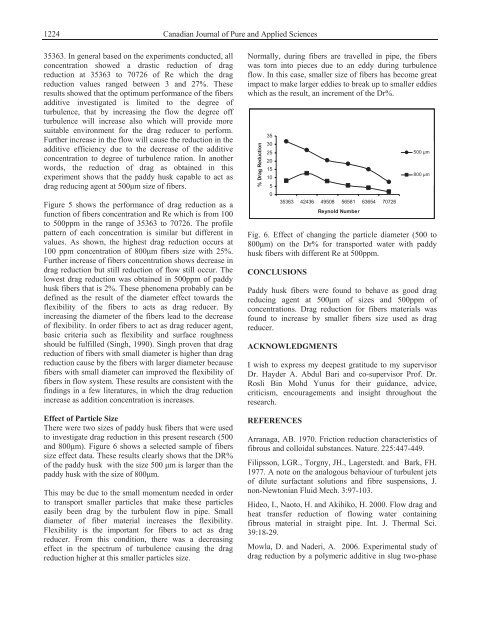Download (5Mb) - Covenant University Repository
Download (5Mb) - Covenant University Repository
Download (5Mb) - Covenant University Repository
Create successful ePaper yourself
Turn your PDF publications into a flip-book with our unique Google optimized e-Paper software.
1224<br />
35363. In general based on the experiments conducted, all<br />
concentration showed a drastic reduction of drag<br />
reduction at 35363 to 70726 of Re which the drag<br />
reduction values ranged between 3 and 27%. These<br />
results showed that the optimum performance of the fibers<br />
additive investigated is limited to the degree of<br />
turbulence, that by increasing the flow the degree off<br />
turbulence will increase also which will provide more<br />
suitable environment for the drag reducer to perform.<br />
Further increase in the flow will cause the reduction in the<br />
additive efficiency due to the decrease of the additive<br />
concentration to degree of turbulence ration. In another<br />
words, the reduction of drag as obtained in this<br />
experiment shows that the paddy husk capable to act as<br />
drag reducing agent at 500µm size of fibers.<br />
Figure 5 shows the performance of drag reduction as a<br />
function of fibers concentration and Re which is from 100<br />
to 500ppm in the range of 35363 to 70726. The profile<br />
pattern of each concentration is similar but different in<br />
values. As shown, the highest drag reduction occurs at<br />
100 ppm concentration of 800µm fibers size with 25%.<br />
Further increase of fibers concentration shows decrease in<br />
drag reduction but still reduction of flow still occur. The<br />
lowest drag reduction was obtained in 500ppm of paddy<br />
husk fibers that is 2%. These phenomena probably can be<br />
defined as the result of the diameter effect towards the<br />
flexibility of the fibers to acts as drag reducer. By<br />
increasing the diameter of the fibers lead to the decrease<br />
of flexibility. In order fibers to act as drag reducer agent,<br />
basic criteria such as flexibility and surface roughness<br />
should be fulfilled (Singh, 1990). Singh proven that drag<br />
reduction of fibers with small diameter is higher than drag<br />
reduction cause by the fibers with larger diameter because<br />
fibers with small diameter can improved the flexibility of<br />
fibers in flow system. These results are consistent with the<br />
findings in a few literatures, in which the drag reduction<br />
increase as addition concentration is increases.<br />
Effect of Particle Size<br />
There were two sizes of paddy husk fibers that were used<br />
to investigate drag reduction in this present research (500<br />
and 800µm). Figure 6 shows a selected sample of fibers<br />
size effect data. These results clearly shows that the DR%<br />
of the paddy husk with the size 500 µm is larger than the<br />
paddy husk with the size of 800µm.<br />
This may be due to the small momentum needed in order<br />
to transport smaller particles that make these particles<br />
easily been drag by the turbulent flow in pipe. Small<br />
diameter of fiber material increases the flexibility.<br />
Flexibility is the important for fibers to act as drag<br />
reducer. From this condition, there was a decreasing<br />
effect in the spectrum of turbulence causing the drag<br />
reduction higher at this smaller particles size.<br />
Canadian Journal of Pure and Applied Sciences<br />
Normally, during fibers are travelled in pipe, the fibers<br />
was torn into pieces due to an eddy during turbulence<br />
flow. In this case, smaller size of fibers has become great<br />
impact to make larger eddies to break up to smaller eddies<br />
which as the result, an increment of the Dr%.<br />
% Drag Reduction<br />
35<br />
30<br />
25<br />
20<br />
15<br />
10<br />
5<br />
0<br />
35363 42436 49508 56581 63654 70726<br />
Reynold Number<br />
500 µm<br />
800 µm<br />
Fig. 6. Effect of changing the particle diameter (500 to<br />
800µm) on the Dr% for transported water with paddy<br />
husk fibers with different Re at 500ppm.<br />
CONCLUSIONS<br />
Paddy husk fibers were found to behave as good drag<br />
reducing agent at 500µm of sizes and 500ppm of<br />
concentrations. Drag reduction for fibers materials was<br />
found to increase by smaller fibers size used as drag<br />
reducer.<br />
ACKNOWLEDGMENTS<br />
I wish to express my deepest gratitude to my supervisor<br />
Dr. Hayder A. Abdul Bari and co-supervisor Prof. Dr.<br />
Rosli Bin Mohd Yunus for their guidance, advice,<br />
criticism, encouragements and insight throughout the<br />
research.<br />
REFERENCES<br />
Arranaga, AB. 1970. Friction reduction characteristics of<br />
fibrous and colloidal substances. Nature. 225:447-449.<br />
Filipsson, LGR., Torgny, JH., Lagerstedt. and Bark, FH.<br />
1977. A note on the analogous behaviour of turbulent jets<br />
of dilute surfactant solutions and fibre suspensions, J.<br />
non-Newtonian Fluid Mech. 3:97-103.<br />
Hideo, I., Naoto, H. and Akihiko, H. 2000. Flow drag and<br />
heat transfer reduction of flowing water containing<br />
fibrous material in straight pipe. Int. J. Thermal Sci.<br />
39:18-29.<br />
Mowla, D. and Naderi, A. 2006. Experimental study of<br />
drag reduction by a polymeric additive in slug two-phase

















